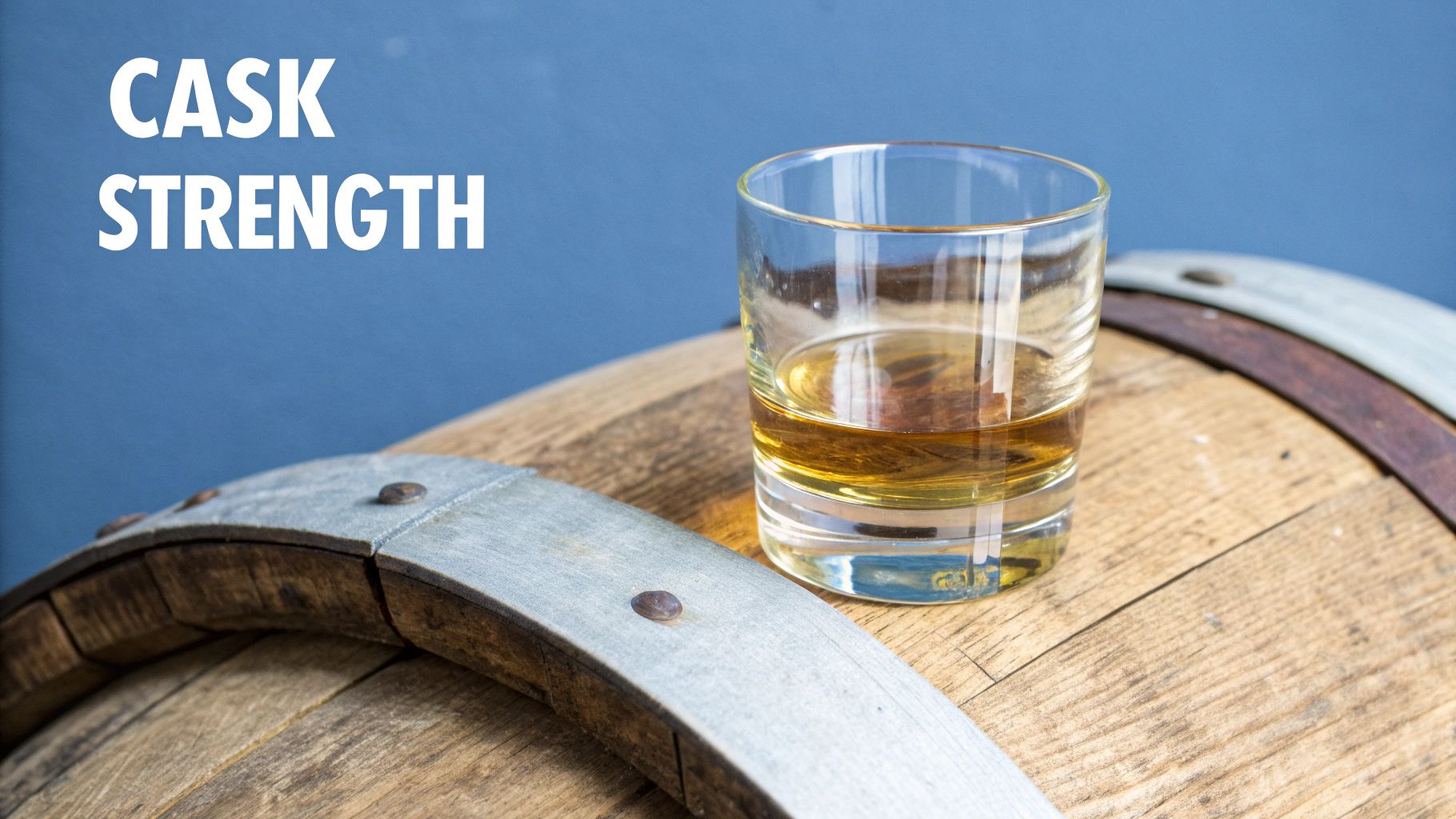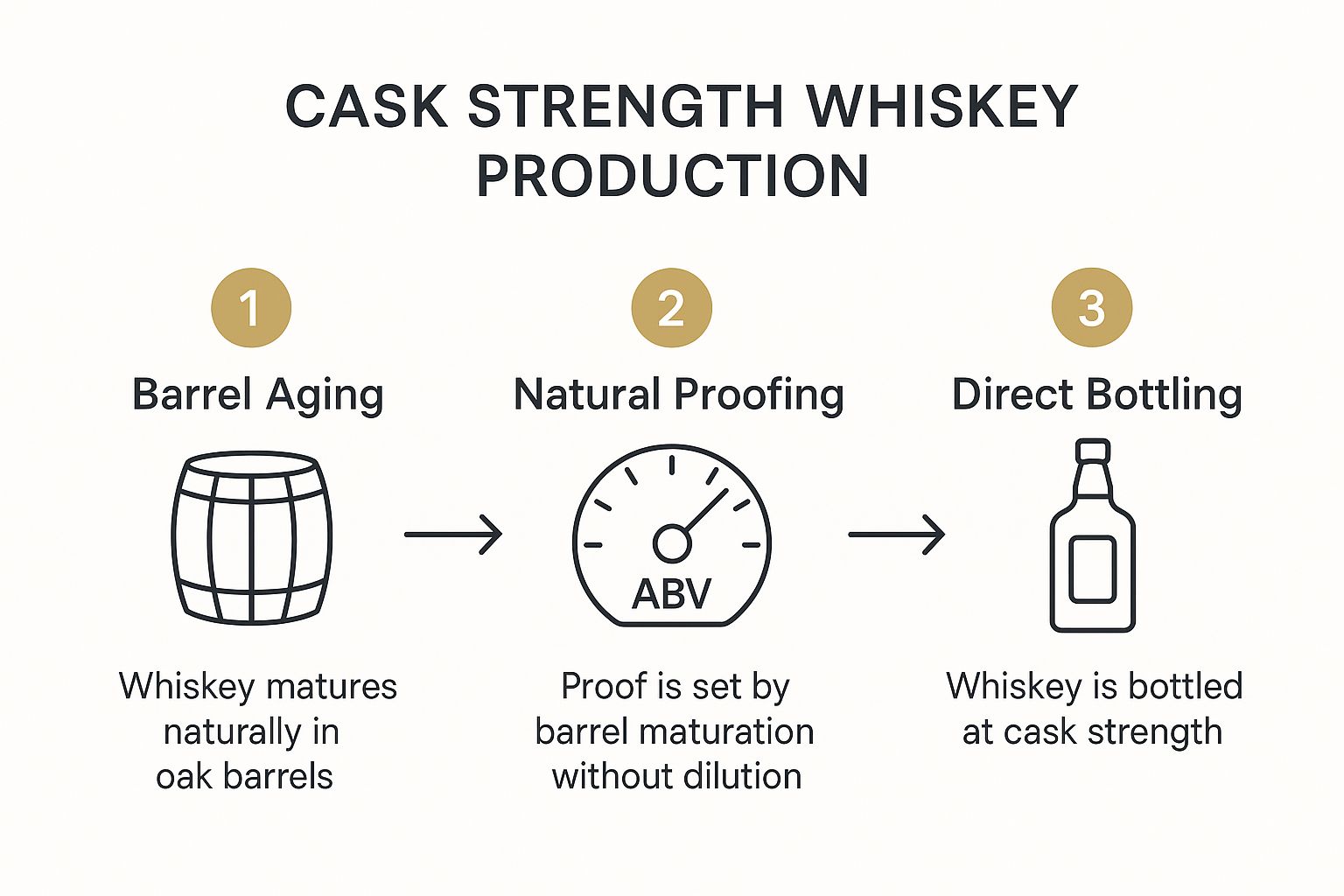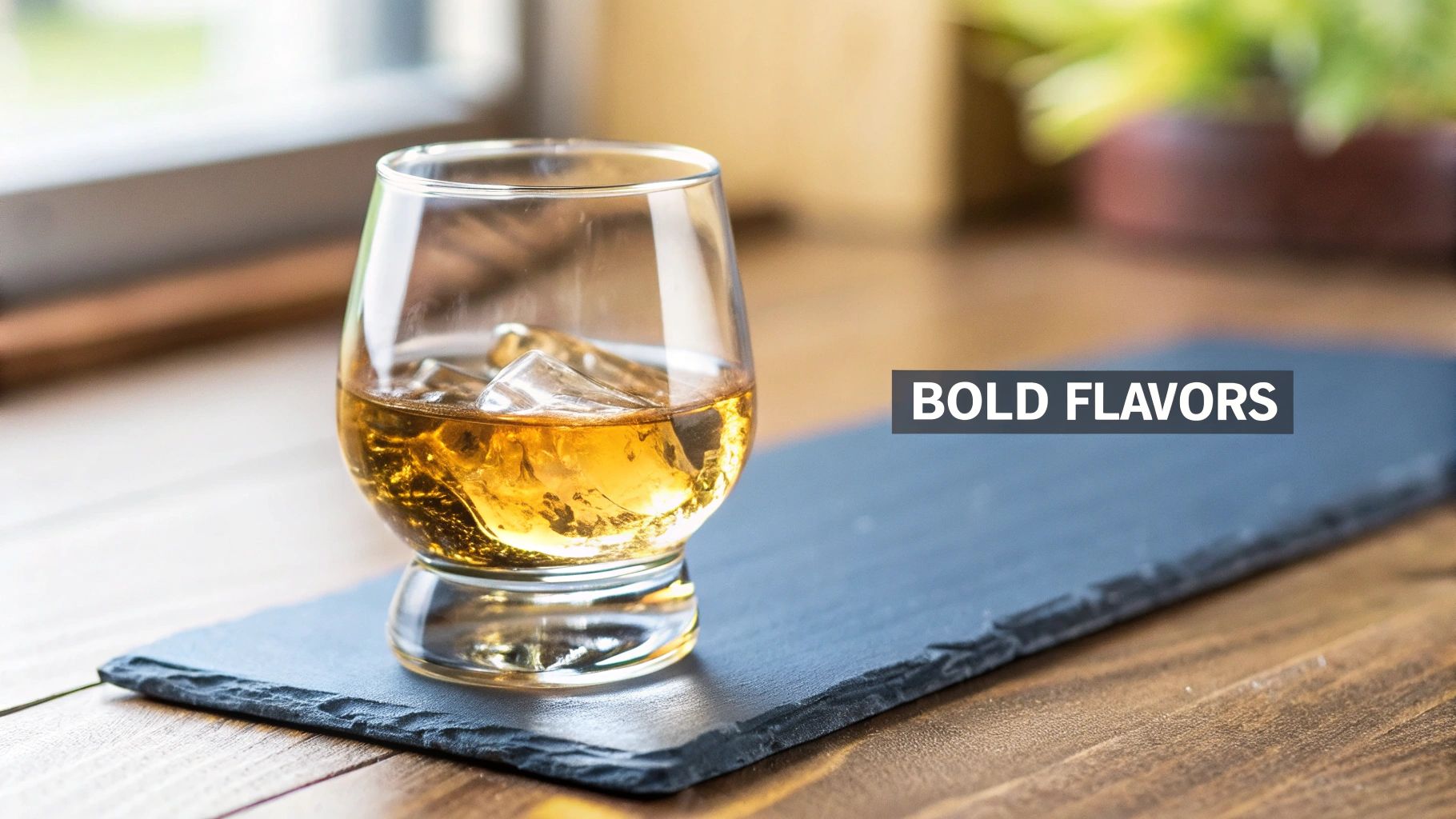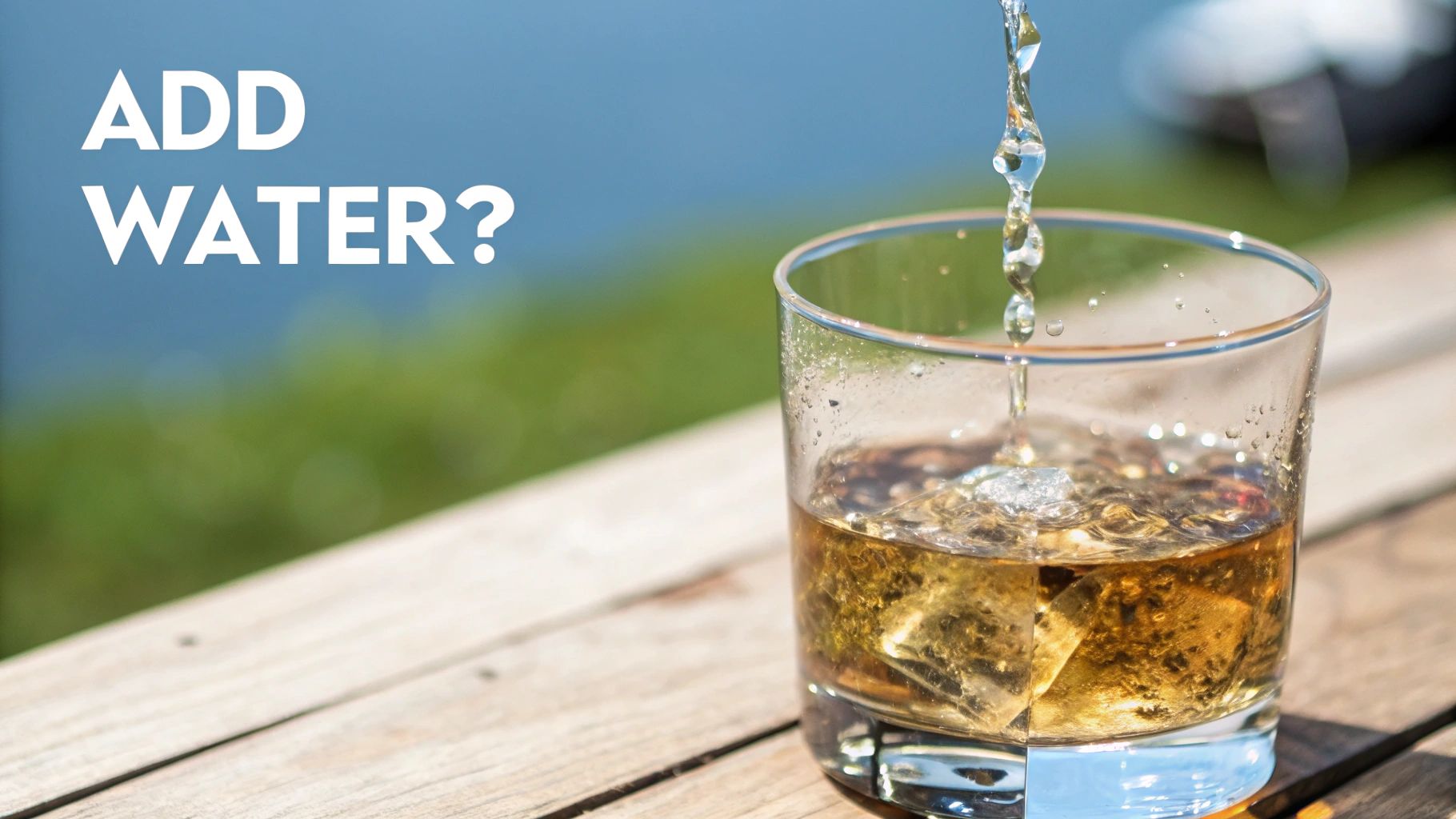Let’s get right to it: cask strength whiskey is the spirit bottled straight from the aging barrel. No filtering, no dilution. It’s whiskey in its purest, most powerful form.
If standard whiskey is your morning drip coffee, cask strength is the bold, concentrated espresso shot that follows. For new whiskey drinkers, it's a chance to taste a spirit exactly as the distiller intended.
Decoding Cask Strength Whiskey

When you spot "cask strength" or "barrel proof" on a label, you’re looking at an honest snapshot of that whiskey exactly as it was inside the barrel. Most whiskeys on the shelf are proofed down—meaning water is added—to hit a consistent, more approachable alcohol level. Cask strength bottlings skip that step entirely.
This "straight from the source" method is exactly why so many whiskey lovers, especially fans of American craft whiskey, get excited about its raw power and untamed flavor. It's a genuine glimpse into the distiller’s craft, delivering an intensity you just won't find in a standard bottle.
The Power of Proof
The first thing most drinkers notice is the serious kick. Cask strength whiskey is bottled without the dilution that most producers use to tame their spirits, which means the alcohol content is significantly higher.
You'll find that typical cask strength releases fall somewhere between 50% and 75% Alcohol by Volume (ABV), often landing right around that 60-65% ABV sweet spot. Compare that to your average whiskey, which is diluted to a predictable 40% ABV to ensure every batch tastes the same and the alcoholic heat is dialed way back. For a deeper dive into the specifics, the team at Blackened Whiskey offers a great breakdown.
But this higher proof isn't just for show; it's all about preserving flavor. By skipping the dilution, distillers are able to keep all the natural oils and flavorful compounds that worked so hard to develop during maturation.
Tip for New Whiskey Drinkers: Trying cask strength is like hearing a familiar song in high-definition audio for the first time. Suddenly you pick up on new details, deeper notes, and a richer overall sound that was always there but previously muted. Don't be intimidated by the high ABV; just start slow.
This creates a uniquely rewarding experience, especially for anyone looking to explore the full, unadulterated spectrum of what a whiskey can be.
Cask Strength vs Standard Whiskey At a Glance
To make the distinction crystal clear, here’s a quick rundown of how these two styles stack up against each other.
| Characteristic | Cask Strength Whiskey | Standard Whiskey |
|---|---|---|
| Dilution | Bottled without adding water | Diluted with water before bottling |
| Proof (ABV) | High; typically 50-75% | Lower; consistently around 40% |
| Flavor Profile | Intense, complex, and unaltered | Milder, more approachable, consistent |
| Consistency | Varies from barrel to barrel | Uniform taste across batches |
| Best For | Experienced drinkers, flavor exploration | Casual sipping, cocktails, beginners |
This table really highlights the core difference: cask strength offers a raw, variable, and powerful experience, while standard whiskey provides consistency and accessibility. Neither is better—they just serve different purposes for different drinkers.
The Journey from Barrel to Bottle
A whiskey’s final character isn’t just about the grain bill or the shape of the still. The real magic happens during its time in the barrel. This maturation phase is where cask strength whiskey truly comes into its own, capturing a specific moment in time without a drop of water to alter its story.
Think of an oak barrel as a living, breathing thing. The climate outside, the temperature swings in the warehouse, and even where that barrel sits in the rickhouse all shape the spirit inside. We dive deeper into the critical role of aging barrels for whiskey in our detailed guide.
From Warehouse Climate to Final Proof
This interactive process is exactly why two whiskeys, made the same way but aged in different climates, can end up with wildly different proofs. The maturation journey directly influences the final alcohol content, which for cask strength bottlings typically lands somewhere between 50% to 75% ABV.
Take Scotland's cool, damp air, for example. Over many years of aging, Scotch often sees a gentle decrease in proof as more alcohol evaporates than water. This is famously known as the "angel's share."
Now, head over to Kentucky. In its hotter, more volatile climate, American bourbons often experience the reverse. More water evaporates from the barrel, causing the proof to climb higher as it ages.
A Tip for Exploring: A great way to experience this is to try bourbons from different American craft distilleries. A cask strength whiskey from a Texas producer will have a very different profile than one from a distillery in a cooler state, purely because of the climate's impact during aging.
This infographic lays out the straightforward, hands-off approach to making a cask strength whiskey.

As the diagram shows, the spirit goes from barrel to bottle completely unaltered. This preserves the authentic proof and flavor developed inside the cask. That commitment to authenticity is what defines the entire category.
Why High Proof Unlocks Deeper Flavors

Ever wondered why the conversation around cask strength whiskey always turns to intense, complex flavors? The secret isn’t about what’s added to the bottle, but what’s intentionally left out: water.
By skipping the dilution step, distillers are preserving every single natural oil, ester, and flavor compound that developed during the whiskey's long slumber inside the barrel.
Think of it like a rich, slow-simmered bolognese sauce. Straight from the pot, it’s a powerhouse of concentrated flavor. That’s cask strength whiskey. It’s the original, potent spirit before it’s thinned out, offering a much bolder and more viscous pour. This higher concentration creates an incredibly layered and robust spirit—a full-spectrum tasting experience that standard-proof whiskeys simply can't match.
How Proof Acts as a Flavor Carrier
The high alcohol content in cask strength whiskey does more than just provide a kick. It’s actually a powerful solvent that carries flavor. Alcohol molecules bind with flavorful compounds like oils and esters that don’t dissolve well in water.
When a whiskey is proofed down, many of these delicate compounds fall out of the solution, which can mute the final taste. The higher proof means you get to discover subtle notes of spice, fruit, and oak that are often lost in standard bottlings. It’s the most authentic taste of the whiskey's journey from grain to glass.
Tip for New Whiskey Drinkers: Approach a high-proof pour with curiosity, not fear. You're not just drinking a stronger whiskey; you're tasting a more complete and honest expression of the distiller’s art, with all its nuances intact.
This is exactly why so many American craft distilleries—like the ones often featured in our blind tasting kits—release cask strength expressions. It’s their way of showcasing the pure, unadulterated character of their spirit. By not adding water, they let the whiskey speak for itself.
How to Drink Cask strength Whiskey

Let's be honest, staring down a bottle of cask strength whiskey can be a little intimidating. Seeing an ABV of 60% or higher might have you bracing for impact, but you’re not alone. The truth is, approaching these powerful spirits is an incredibly rewarding experience that puts you, the drinker, in the driver's seat.
Forget any rigid rules you might have heard. This is all about exploring the whiskey on your own terms. We'll walk you through how to enjoy these potent pours without the overwhelming burn, unlocking the complex, hidden flavors that make them so sought after.
Start by Tasting It Neat
Before you even think about adding water or ice, you have to taste the whiskey in its purest form. This first sip is crucial—it sets your baseline and gives you a raw, unfiltered look at the distiller's handiwork.
- Nose It Carefully: Give the glass a gentle swirl and bring it toward your nose, but keep your mouth slightly open. This little trick helps the intense alcohol vapors bypass your nostrils, letting the actual aromas shine through without the sting.
- Take a Tiny Sip: Seriously, just a small one. Let that little bit of whiskey coat your tongue to get a feel for its texture and raw power. Yes, it’s going to be hot. That’s the point. This first taste wakes up your palate and prepares it for what comes next.
This initial encounter shows you the whiskey's true character. You'll likely get hit with concentrated, powerful notes of oak, caramel, and spice. This is your chance to appreciate the unadulterated spirit.
The Art of Proofing Down
Here’s where the magic happens. Adding water—a technique called "proofing down"—is how you tame that alcoholic heat and unlock entirely new layers of aroma and flavor. Just a few drops can trigger a chemical reaction, releasing aromatic compounds that were previously locked away.
Many American craft distilleries, like Frey Ranch in Nevada, produce cask strength bourbons that completely transform with a bit of water. What starts as an intense wave of spice and oak can open up to reveal delicate notes of dark chocolate, cherry, and vanilla.
Start by adding a single drop of cool water. Give it a swirl and taste it again. You’ll be amazed at how much the profile can shift. Keep repeating the process, one drop at a time, until the whiskey hits that perfect spot for you.
You'll know you've found it when the burn fades into the background and the flavors become clearer, more distinct, and frankly, more enjoyable. This hands-on approach puts you in control, letting you find the perfect balance for your own palate.
Great Cask Strength Whiskeys to Try
Alright, you've got the theory down, but where do you actually start? Let's dive into some real-world examples of cask strength whiskey and talk about a few distilleries that are absolutely knocking it out of the park.
The American craft whiskey scene is on fire right now, with incredible distillers bottling spirits straight from the barrel all over the country. These bottlings are pure, undiluted expressions of their local grain and unique climate. It's the most authentic taste you can get.
Instead of just throwing a list of names at you, I want to highlight a few producers who are truly mastering this bold style. These are perfect starting points for anyone curious about high-proof whiskey because they showcase just how diverse and packed with flavor cask strength can be. Honestly, these are exactly the kinds of distilleries we get excited to feature in our blind tasting kits, connecting drinkers to the real heart of American spirits.
Innovators in High-Proof Spirits
-
For the High-Rye Bourbon Fan (Stellum Spirits): This is a project from the master blenders behind Barrell Craft Spirits, so you know they know what they're doing. Stellum is all about the art of the blend. Their cask strength bourbon often leans on a spicy, high-rye mash bill that delivers a powerful punch of black pepper, cinnamon, and deep caramel that holds its own against the high proof. It's a masterclass in how blending can create a barrel-proof spirit that's both complex and incredibly balanced.
-
For the Unique Cask Finish Lover (Hardin's Creek): Coming from the legendary James B. Beam Distilling Co., the Hardin's Creek line is all about exploration. They release limited, high-proof expressions that zero in on specific parts of the whiskey-making process. Their cask strength bottlings are a deep dive into the magic of aging, often bursting with rich flavors of vanilla, toasted oak, and dark fruit that you can only get from an unfiltered, undiluted bourbon.
-
For the Single Barrel Purist (Frey Ranch Distillery): As a genuine farm-to-bottle operation out of Nevada, Frey Ranch has built a fiercely loyal following for its single barrel cask strength releases. Every single bottle is drawn from one individual cask and bottled at its natural proof, giving you a perfect snapshot of that specific barrel's life. Expect a wave of butterscotch, clove, and orange peel that beautifully showcases the quality of the grains they grow themselves.
Tip for New Drinkers: If you're just starting your cask strength journey, begin with a brand known for its balance, like Frey Ranch or Hardin's Creek. While their offerings are definitely powerful, they often have an underlying sweetness and complexity that makes the high proof much more approachable. It’s a great way to train your palate for the intensity.
American Craft Cask Strength Whiskeys to Try
To help you get started, here is a curated list of a few more excellent cask strength whiskeys from the American craft scene. These are great entry points because they deliver that high-proof intensity without sacrificing balance and flavor.
| Distillery/Brand | Whiskey Type | Common Tasting Notes | Why It's a Good Starting Point |
|---|---|---|---|
| Stellum Spirits | Blended Bourbon | Black pepper, cinnamon, cherry, rich caramel | A fantastic example of expert blending that creates a balanced yet bold high-rye profile. |
| Frey Ranch | Single Barrel Bourbon | Butterscotch, clove, orange peel, baking spice | Its farm-to-bottle approach yields a rich, grain-forward whiskey that is powerful but smooth. |
| Hardin's Creek | Bourbon | Vanilla bean, toasted oak, dark fruit, leather | Showcases exceptional age and barrel character, making the high proof feel integrated and complex. |
| Jack Daniel's | Single Barrel Barrel Proof Tennessee Whiskey | Banana, brown sugar, dark chocolate, oak | Surprisingly approachable for its proof, it offers a classic, rich flavor profile that's a benchmark in the category. |
These selections are just the tip of the iceberg, but they represent the quality and diversity you can find when you step into the world of cask strength American whiskey. Each one tells a unique story of its origin, from grain to glass, without a drop of water to get in the way.
Is Cask Strength Whiskey a Better Value?
That higher price tag on a bottle of cask strength whiskey might give you pause, but it's often a much smarter buy than you think. When you really break it down, the math can reveal a hidden value that standard-proof bottles just can't match.
With cask strength, you're paying for pure, undiluted whiskey—not the added water that makes up a big chunk of a standard bottle. This means you’re simply getting more actual whiskey for your dollar. It’s like buying a concentrate instead of a pre-mixed drink; the initial cost is higher, but what you can get out of it is far greater.
The Power of Versatility
The real economic advantage of cask strength whiskey lies in its incredible versatility. A single bottle offers you two distinct experiences and effectively stretches your investment.
- Enjoy it at full strength: You can sip it neat to experience the bold, unaltered flavor profile exactly as the distiller intended. This is the whiskey in its purest form.
- Proof it down yourself: You can add water to your liking, customizing each and every pour. By doing this, you are essentially creating more servings from one bottle, extending its life and value far beyond a standard 40% ABV spirit.
Tip for New Whiskey Drinkers: Think of a cask strength bottle as a home bar multitool. One purchase gives you both a powerful, neat pour and a customizable base that you can adjust for different occasions or even for crafting robust cocktails that won't get watered down.
This flexibility makes cask strength a truly dynamic and economical choice for any whiskey enthusiast, from the curious beginner to the seasoned connoisseur. You’re not just buying a stronger whiskey; you’re buying more options.
Answering a Few Lingering Questions
Even with a solid grasp of the basics, a few questions always seem to hang in the air when people first dive into the world of high-proof whiskey. Let's tackle some of the most common ones head-on so you can feel totally confident on your cask strength journey.
Is Cask Strength "Better" Than Regular Whiskey?
That’s like asking if a spicy chili is "better" than a mild one. It's not about better or worse, but about intensity and preference.
Cask strength whiskey delivers a raw, powerful, and unaltered taste straight from the barrel. It’s the purest expression of the distiller’s craft, and that’s what many enthusiasts are chasing. On the other hand, a standard bottling is crafted for smoothness and consistency. It all boils down to what you're in the mood for.
Can You Actually Use Cask Strength Whiskey in Cocktails?
You absolutely can, and you absolutely should. Its high proof is a huge advantage, allowing the whiskey’s core flavors to punch through other ingredients instead of getting lost.
Making an Old Fashioned or a Manhattan with a cask strength spirit creates a cocktail with incredible depth and richness. The whiskey doesn't just participate; it leads the charge.
What's the Difference Between Cask Strength and Barrel Proof?
In the real world, you'll see these terms used interchangeably all the time. For all intents and purposes, they promise the same thing: a potent, undiluted whiskey.
That said, "barrel proof" can have a slightly stricter legal definition here in the U.S. It typically means the whiskey is bottled at the exact proof it was when it was dumped from the barrel, or extremely close to it. But for us drinkers, both terms signal a bold and authentic experience.
Ready to put your palate to the test and discover your next favorite American craft whiskey? At Blind Barrels, we remove the bias and let you focus purely on flavor. Explore our blind tasting kits and find incredible spirits you won't see on every shelf. Join the experience at Blind Barrels.
